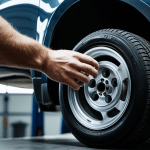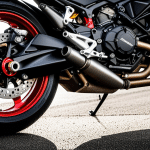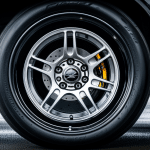Understanding Oil Leaks in the KTM 1290 Super Duke GT
Oil leaks in the KTM 1290 Super Duke GT can manifest in several noticeable ways. Recognising these oil leak symptoms early is key to addressing them efficiently. Some frequent indicators include oil puddles beneath the motorcycle, increased oil consumption, and visible oil stains on the engine or exhaust. If these signs are not addressed, they can lead to performance issues and costly repairs.
Several factors contribute to oil leaks in motorcycles like the KTM 1290 Super Duke GT. These include regular wear and tear, which can degrade seals and gaskets over time, causing them to fail. Additionally, environmental factors like extreme temperatures and humidity can exacerbate the breakdown of these components.
Cela peut vous intéresser : Master DIY Tutorial: Expert Tips for Replacing Your Kawasaki Ninja 400 Rear Shock Absorber like a Pro!
Timely detection and repair of oil leaks are crucial. Ignoring oil leak symptoms could result in engine damage or reduced safety on the road. Regular motorcycle maintenance, such as periodic inspections of seals and gaskets, can significantly reduce the risk of leaks. Maintaining an appropriate oil level and ensuring the integrity of engine components are also vital measures to prevent oil leaks and keep the KTM 1290 Super Duke GT running smoothly.
Diagnosing Oil Leaks
Diagnosing oil leaks in a motorcycle such as the KTM 1290 Super Duke GT requires a systematic approach. Proper oil leak diagnosis often begins with a visual inspection. Identifying the location of oil accumulation or stains is the first step. Pay particular attention to areas around the engine, exhaust, and the ground beneath the motorcycle.
A lire en complément : Top Tips to Extend Your BMW R1200GS Battery Life
Preliminary Inspection Techniques
Start with a thorough visual inspection. Examine all visible areas of the engine and exhaust for fresh oil stains. A clean microfiber cloth can help detect smaller leaks. Look for changes in oil levels, as sudden drops could indicate significant leakage.
Identifying Oil Stains and Their Sources
To locate the origin of an oil leak, inspect the seals and gaskets thoroughly. Look for signs of wear or degradation. A die method, using UV dye added to the oil, can highlight leak paths under UV light, making it easier to see hidden leaks.
Tools for Diagnosing Oil Leaks
Essential diagnostic tools include pressure testers and dye methods. Pressure testers help identify possible gasket failures by testing engine pressure. Regular checks on oil levels are crucial during the diagnosis, ideally using the bike’s level indicator to ensure accuracy. This method helps confirm the oil leak’s severity and dictates the urgency of repair.
Repairing Oil Leaks: Step-by-Step Guide
Repairing oil leaks in your motorcycle requires methodical preparation and execution to ensure success. With the right approach, many oil leak issues in the KTM 1290 Super Duke GT are manageable.
Essential Tools for Repair
Possessing the correct tools is vital for effective oil leak repair. Crucial items include wrenches, sealant, gasket materials, and a torque wrench. Quality tools ensure precision and avoid further damage during DIY motorcycle repair.
Step-by-Step Repair Process
Begin by thoroughly cleaning the area around the leak to reveal the gasket or seal causing the problem. Remove the faulty component carefully, ensuring no debris enters the engine. Replace it with a new, correctly fitted part. Use appropriate sealant to guarantee a tight seal assembly. Properly torque all fasteners according to manufacturer specifications to prevent recurring issues.
Safety Precautions During Repair
When working on oil leaks, safety is paramount. Utilize protective gear such as gloves and goggles to prevent oil exposure. Handle all tools and engine components with care. Dispose of used oil responsibly to avoid environmental harm. Following these procedures not only ensures your safety but also maintains the integrity of your KTM 1290 Super Duke GT.
Common Causes of Oil Leaks
Understanding the oil leak causes in the KTM 1290 Super Duke GT can guide owners in preventing and addressing issues before they require extensive repairs. One primary factor is gasket failure. Over time, wear and tear from regular use can cause these components to degrade, leading to leaks, especially in motorcycles.
The KTM 1290 is particularly susceptible to leaks in areas such as the engine’s seals and oil pan. Frequent temperature fluctuations can further compromise these parts by causing them to expand and contract, thus increasing the risk of leaks. Addressing such environmental impacts can lessen future leak issues.
Routine motorcycle maintenance plays a crucial role in minimizing the possibility of oil leaks. Regularly inspecting all seals for signs of wear and promptly replacing any compromised gaskets ensures the KTM 1290 remains in optimal condition. Consider the external environment and adopt storage solutions that mitigate temperature extremes.
Conclusively, understanding and proactively addressing these typical causes can significantly enhance the durability and performance of your KTM 1290 Super Duke GT. This foresight positions riders to enjoy their motorcycles with fewer unplanned disruptions.
Preventive Maintenance to Avoid Oil Leaks
Implementing motorcycle maintenance tips is vital for avoiding oil leaks in the KTM 1290 Super Duke GT. Routine checks focus on maintaining optimal condition, identifying issues before they escalate.
Start by regularly inspecting seals and gaskets for signs of wear. Look for cracks or brittleness that could lead to leaks. Perform checks under a controlled environment where you can lift components for thorough inspection. Address potential problem areas by replacing faulty parts promptly.
Oil leak prevention is about maintaining a consistent regime. Regular oil changes remove debris that could damage parts. Ensure the oil used matches the KTM 1290’s specifications to prevent unnecessary wear. Monitor all fluid levels closely, adjusting as needed to avoid strain on engine components.
Ensure seals and gaskets are clean and free of residue. Residue can mask faults and confuse diagnoses. Cleaning these components refreshes their condition and prepares them for further service. Also, adopt proper storage techniques to shield the KTM 1290 from environmental factors like excessive humidity, which degrades seals over time. These practices greatly enhance the KTM 1290’s resilience and performance.
Troubleshooting Persistent Oil Leaks
Persistent oil leaks in the KTM 1290 Super Duke GT can be tricky to resolve, but knowing when to take action can make a big difference. Let’s dive into some advanced repair techniques and resources for handling these issues effectively.
When to Seek Professional Help
If DIY solutions don’t rectify the issue, or if the oil leak expands rapidly, it’s advisable to seek professional assistance. Specialised mechanics can offer precise oil leak troubleshooting through advanced diagnostic tools and expertise. This option ensures that underlying problems are thoroughly inspected and resolved.
Tracking Down Hard-to-Find Leaks
For elusive leaks, a combination of pressure testing and UV dye methods can highlight problem areas that are otherwise invisible. These techniques focus on hard-to-reach sections around the engine and its components, providing clarity and saving time during KTM 1290 issues repair.
Additional Resources for Further Learning
Explore detailed guides and manuals specific to KTM 1290 maintenance to enhance your repair knowledge. Participate in online communities where enthusiasts share tips and experiences. Consider attending professional workshops, which offer hands-on experience and delve into best practices for advanced repair techniques. These resources empower owners with the insights and skills needed for effective motorcycle care.






